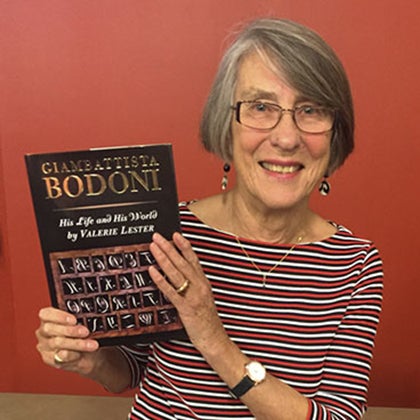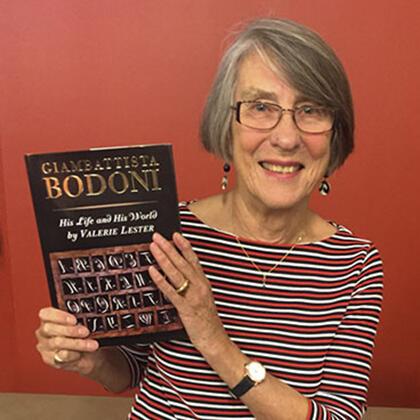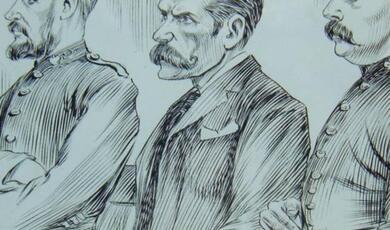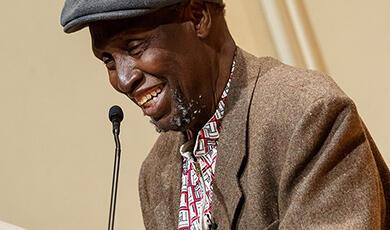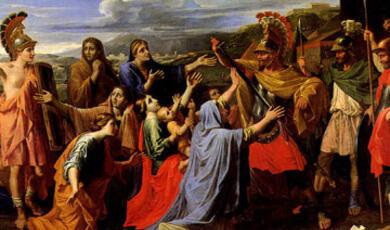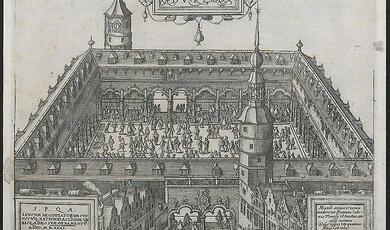Phiz, Dickens and London
Share
- Details
- Text
- Audio
- Downloads
- Extra Reading
Valerie Browne Lester brought Hablot Knight Browne ('Phiz') to life in an illustrated lecture which revealed his London origins. She also discussed sites that he and Dickens frequented together, and explained how artists and author reinvented them for London scenes in the novels on which they collaborated.
Download Text
PHIZ, DICKENS, AND LONDON
Velarie Browne Lester
Charles Dickens radiated such light during the 19th century that many of those who worked within its range were overcast by a huge, greedy shadow. Precious little is known about these people and their lives, while every twitch of Dickens's eyebrow has been scrutinized and described to a hair. One of those working in obscurity was Dickens's principal illustrator, Hablot Knight Browne, better known by his pseudonym, Phiz. It has been my mission for the past ten years to fling off the shadow.
I am dividing this lecture into three parts. First I will talk about Phiz's life so that you will learn where he came from and how he inherited his talent. In the second part, I will tell you about the places he lived in London. And in the third part I will address his relationship with Dickens and describe how, together, they used various sites -- not all of which are in London -- for some of their most famous scenes in the novels on which they collaborated.
PART 1
1. (PHOTO OF PHIZ) The words "principal illustrator" are by no means an understatement because Phiz illustrated 10 of Dickens's big books in their 23-year collaboration. (I am talking here about the novels and am not including sketches, plays, pamphlets, and the Christmas books.) Phiz was hired by the author in 1836 to illustrate The Pickwick Papers after the suicide of Robert Seymour and the subsequent hurried hiring and even more hurried firing of Robert Buss. Seymour had provided illustrations for the first two parts of Pickwick, and Buss provided them for the third. Phiz -- and Sam Weller -- (2. BLOW-UP OF SAM) burst onto the scene in Part IV, and immediately the sales of Pickwick Papers skyrocketed. Three other illustrators -- George Cruikshank, Marcus Stone, and Luke Fildes -- each illustrated just one novel, while George Cattermole collaborated with Phiz on two, with Phiz, however, producing the lion's share of work. His total of ten novels clearly earns him the laurel "Principal Illustrator."
Born on Kennington Lane on July 12, 1815, he was the fourteenth of 15 children in the household of William Loder Browne and Catherine Hunter Browne. Note that I say that he was part of the household of Mr and Mrs Browne rather than that they were his parents. His true parents appear to have been their oldest daughter, Kate Browne, and Captain Nicolas Hablot, a horse grenadier in the Old Guard of Napoleon's Imperial Guard. (3. PHOTO OF GRENADIER A CHEVAL) Kate met Captain Hablot when he was a prisoner on parole in England before he was sent back to France, probably in exchange for a French soldier of the same rank. Shortly thereafter, Mrs Browne and several of the children moved to France, leaving behind Mr Browne, and the older boys, who were in boarding school. She set up house in St. Omer in the Pas-de-Calais during the short-lived period of peace while Napoleon was in Elba. It appears that Kate became pregnant with Phiz by Captain Hablot during that time. She was 21; he was 34.
On 5 March 1815 word reached Paris that Napoleon had escaped from Elba, landed in Provence, and was crossing the Maritime Alps, making for the capital and amassing soliders along the way. Boney was back! The expatriate community fled to the coast like lemmings and leapt into the first boats back to the safety of England, the Browne family included.
Phiz was born one month after the Battle of Waterloo. The family assumed that Captain Hablot had lost his life on the field of battle, (4. PHOTO OF WATERLOO) and absorbed Phiz into its midst. He was always referred to as the son of William and Catherine Browne, Kate as his sister, and her role in his birth was kept a secret. But the baby was baptized Hablot Knight Browne, in memory of the gallant captain. Gallant? It turns out that Nicolas Hablot did not lose his life at Waterloo, in spite of being seriously injured in the chest and both thighs. He retired from the army and returned to Carignan in eastern France, where a year later he married a local 18-year-old.
The Brownes have always pronounced "Ablo" as "Hablo," acknowledging the unsounded 't' of the French, but firmly aspirating the H in a fine example of British mulishness vis à vis the French language. There is no circumflex on the "o" even in France, in spite of vigorous assertions on its part by many journalists and authors. Phiz inherited his colouring -- olive skin, brown hair, hazel eyes (unlike his siblings' blond, blue-eyed traits) -- from his French father, and his artistic talent from the Brownes. The family was descended from Huguenots by the names of Bruneau and Descharmes who had escaped from France some time between the Massacre of St Bartholomew's Day and the Revocation of the Edict of Nantes. Phiz's great-grandparents lived on Brick Lane, in Spitalfields, and were buried in Nicholas Hawksmoor's masterpiece, the magnificent Christ Church, Spitalfields, then newly completed. (5. IMAGE OF CHRISTCHURCH) (This church has just undergone a superb restoration and is well worth a visit). Members of the Browne family worked as watchmakers, silk weavers, and calligraphers -- and thus, Phiz inherited a talent for working on a very small scale in a cultural environment that encouraged it. His grandfather, Simon Browne, (6. SIMON BROWNE) a headmaster and writing teacher in Norwich, was renowned for his calligraphy and became known as the Norwich Pen Man. Note his quill pen at the bottom of the picture. Here is some of his work. (7. S. B.'s CALLIGRAPHY) And here is an enlargement of the bee. (8. BEE) His uncle, John Henry Browne, (9. J.H.B.) was a also headmaster, an extremely competent landscape painter, and friend of John Crome ("Old Crome") the founder of the Norwich School of painting. It is possible to see the influence of both men on Phiz's work -- in the area of watercolor landscapes.
When Phiz was seven, his official father, William Loder Browne, abandoned his wife and many children, absconded with trust funds, changed his name, and sailed to Philadelphia. Mrs Browne promptly declared him dead. But, like Captain Hablot, Mr Browne began a new life. He became an artist who painted antiquarian buildings for the record, and was one of the first lithographers in the United States. He lived on as William Breton for another 33 years, dying in his easy chair after a busy day at the age of 84. If you are ever in Philadelphia, I'm sure you would enjoy a visit to the Historical Society of Pennsylvania to examine their fascinating collection of William Breton's drawings and lithographs.
With her husband's departure from England, Mrs Browne became dependent on the kindness of relatives, including her son-in-law, Elhanan Bicknell, a wealthy industrialist and collector of the works of William Turner. After Phiz had spent several years at boarding school in Suffolk, where his talent was recognized and encouraged by Mr Haddock, the headmaster, Bicknell removed him from the school. The industrialist knew the meaning of working for a living, and was determined that Phiz be able to support himself. He sent him for training to Finden's, the leading engravers of the day, located at 18-19 Southampton Place. This was not a happy choice. Phiz hated the slavery of engraving other people's images. He far preferred etching his own designs, and he also had a firm notion that he would become a fine artist one day. He cancelled his indentures and with Robert Young, a friend from Finden's, rented a studio,and began painting like mad. Another friend from Finden's, Henry Winkles, hired him to provide etchings for a beautiful volume, Cathedral Churches of England and Wales, (10. IMAGE OF ST. PAUL'S)
When he was 25, Phiz married 16 year-old Susannah Reynolds at Holy Trinity Church, Marylebone. (11. HOLY TRINITY) Designed by Sir John Soane, architect of the Bank of England, it was one of the "Waterloo" churches, consructed with the thanksgiving fund allocated by Parliament to celebrate the nation's deliverance from invasion by the French.
Phiz and Susannah produced a total of 12 children, nine of whom survived into adulthood, and all of whom were artistically talented. His son, Gordon Browne, followed in his footsteps and became a famous illustrator in his time, known primarily for illustrating the works of G.H. Henty.
Phiz was a shy, optimistic, and deeply humorous man who adored his family and loved nothing more than riding a horse. But he was a terrible businessman. Feast or famine ruled his life, and he never thought of saving. Towards the end of his days, his style of illustration became outmoded and he suffered a paralytic illness which curtailed his use of the etching needle, although he could still paint, and draw designs for wood engravings. He became desperately poor, but at the instigation of Luke Fildes and others, the Royal Academy stepped in and awarded him an annuity. He died, as he -- the eternal optimist -- had predicted, "tolerably comfortable," at Brighton on July 10, 1882, having provided illustrations for over 200 books and countless magazines. Among the many other writers with whom he collaborated were Harrison Ainsworth, Robert Surtees, Frank Smedley, Anthony Trollope (disastrous!) and Charles Lever, for the last of whom he illustrated 18 books in a 26-year partnership.
PART 2
Phiz resided in London most of his life -- apart from the stint at boarding school in Suffolk, a hiatus in the wilds of Surrey in his middle years, and the two years in Brighton at the end of his life. His birthplace, Kennington Lane, was south of the Thames, not far from the Vauxhall Gardens, the Bethlehem Hospital for Lunatics (Bedlam), and St. Mary's, Lambeth, (now the Museum of Garden History) where he was baptized by "the preacher at the asylum."
Shortly after William Loder Browne left for America in 1822, the rest of the family moved to Euston Square, (12. 1838 MAP OF LONDON) and that general area became Phiz's home territory for several years. He seemed to like moving because between leaving Finden's and marrying Susannah he lived in Bedford Place, Newman Street, Warren Street, and Fitzroy Street -- or perhaps his life as a struggling young artist forced him to change lodgings with embarrassing frequency.
The British Museum was his favorite haunt. Often, when running errands for Finden's, he would drop in and spend time with the Elgin Marbles, admiring the horses in particular. (13. ELGIN HORSE) He was crazy about horses and his son, Edgar, declared that Phiz would never walk fifty yards if he could throw his leg over a horse.
At the time he was hired to work for Dickens, Phiz was living at 14 Bedford Place (which connects Russell Square and Bloomsbury Square) and still had his studio at No. 3 Furnival's Inn, unaware that Dickens had lodgings first at No. 13 and then at No. 15. (14. OLD IMAGE AND 15. NEW PHOTO OF FURNIVAL'S INN now PRUDENTIAL ASSURANCE). Just across the road?? As soon as they did meet, they became friends as well as collaborators. Shortly after Dickens's marriage, he moved to 48 Doughty Street (16. IMAGE OF DICKENS MUSEUM), a building that many of you will be familiar with, where Phiz was a frequent guest. At the time of his own marriage in 1840, Phiz lived on Fitzroy Street, but after the wedding he and Susannah rented a house on Howland Street, where the first of their children were born. They later moved, for the sake of Susannah's health, to Stamford Villas in the deep west -- Fulham -- where the air was cleaner. (17. IMAGE WITH DOGHOUSE)
Then came Surrey. (18. BANSTEAD HEATH). This painting is of particular interest to me. It is reproduced in Edgar Browne's book about his father, Phiz and Dickens, but I first read about it in an essay by John Fowles in which he described it as "spacious and very skilled" and admitting that he bought it from a dealer for £2 when the asking price was £5. The dealer had no idea what the initials H.K.B. stood for. John Fowles died a year ago this month, and I have recently made a deal with his widow, Sarah, to buy the painting. I need hardly tell you that the price has gone up a bit!
On Phiz's return to London from Surrey, he lived first in Horbury Crescent, half-way between Holland Park and Notting Hill, then Blenheim Crescent (19). BLENHEIM CRESCENT) and finally at 99 Ladbroke Grove Road (now 239 and sporting a handsome new blue plaque celebrating him) (20. 239 LADBROKE GROVE). He named this building "Bleak House" because, being at the end of the row, it caught the wind and was very draughty. Three of his sons attended Bruce Castle school in Tottenham, whose headmaster was Arthur Hill, brother of the more famous Sir Rowland Hill. Dickens also considered Bruce Castle, known for its passionate liberalism, for his oldest son, but was overruled by Angela Burdett Coutts who insisted that Charley go to Eton -- at her expense. Phiz moved to 8 Clarendon Villas in Brighton (technically Hove, I think) in 1880 where he spent his last two years. (21. CLARENDON VILLAS) The building was brand new at the time, and would have presented a more appealing mien.
PART 3
Phiz's truly lucky break came when he was suddenly chosen to pick up the reins on Pickwick Papers, following the aforementioned suicide of Robert Seymour and the firing of Robert Buss. He was not yet 21 at the time, and his age was in his favor. Dickens wanted someone young and agreeable, someone he could dominate. Competition for the job was fierce. Alfred Forrester, better known as "Crowquill," William Lee, and William Thackeray all applied, but Phiz with his easy-going nature, his youth, and his remarkable skill as an etcher satisfied Dickens's requirements. (Thackeray was a good loser and took Phiz out to celebrate his success with a fine dinner of sausages and stout.) Even the 19 year-old John Leechs ubmitted a drawing for Dickens's consideration, but he was too late, that time. Dickens responded to Leech's application, saying "[T]he plates for the Pickwick Papers are in the hands of a gentleman of very great ability, with whose designs I am exceedingly well satisfied, and from whom I feel it neither my wish, nor my interest, to part." But Dickens did not, of course, forget John Leech when it came time to hire an illustrator for A Christmas Carol.
Knowing the fate of his predecessors made Phiz particularly anxious to produce a first-rate etching for Dickens. The subject was to be "The First Appearance of Mr Samuel Weller" which was perfect for his purpose. Even as he adhered to Seymour's concept of Mr Pickwick, he could make his own impression on the newcomer, Sam Weller, and the background scene. Dickens writes: "It was in the yard of one of these inns -- of no less celebrated a one than the White Hart -- that a man was busily employed in brushing the dirt off a pair of boots," and this jaunty "Boots" came alive under Phiz's stylus. (22. SAM WELLER AGAIN)
As soon as he received Dickens's approval for the design and had drawn the image carefully through the "ground" (a coating of wax and asphaltum) in reverse on a steel plate, he called for his friend Robert Young, a wizard with aqua fortis -- the acid -- to perform the biting-in process. They worked throughout the night and by early the next morning were able to present Dickens, his publisher, and the reading public with an image that fired their imaginations. Not only were Dickens's readers charmed by the characters, but they set to wondering about the whereabouts and identity of the inn in the background. It strikingly resembles the George in Southwark, with its courtyard and balconies.
Phiz signed the initials N.E.M.O. "Nemo" or "No One" on his first four plates, but took the pseudonym of Phiz thereafter, as he said "to harmonize . . . better with Dickens's Boz." There are other reasons. It happens that physiognomy was all the rage at the time; it is also true that the word "phiz" is slang for face; and Dickens had just introduced a character called Fizkin into the novel. Phiz was definitely in the air. With "The First Appearance of Mr Samuel Weller" and the sudden, astonishing popularity of Pickwick -- sales zoomed up from 400 to 40,000 copies per monthly part -- Phiz's career as an illustrator was assured, as was his friendship with Charles dickens. In the first years of their collaboration, they became constant companions, travelling all over the country together, even going abroad together, along with Dickens's wife, to recover from the death of her sister, Mary Hogarth. (23. PHIZ DRAWING OF MARY) I have decided that this is a picture, by Phiz, of Mary. It showed up in a collection of drawings purporting to be of Kate Nickleby, but it is a far more finished piece of work than the rest of the sketches. It is, in fact, a portrait. And I believe that the figure under the cloche on the left is a clue, a reference to Sir Walter Scott, to whom the Hogarths were related. Dickens enjoyed Phiz's amiability and quiet humor; Phiz was drawn to Dickens's flash and dash. They even enjoyed playing battledore-and-shuttlecock together.
In May 1837, Dickens, Forster, Cattermole, and Phiz took a long walk, first to Coldbath Fields, where they were joined by the actor, William Macready, before proceeding on Newgate prison. 1 It was about this time that Phiz produced the image, "Mrs Bardell encounters Mr Pickwick in the prison." (24. MRS. BARDELL) It is unlikely, however, that Phiz was drawing the actual Newgate in any way but subliminally when he executed this image. He far preferred working from his own imagination, in team with his strong sense of composition, to drawing from the actual.
With glimmerings of a new novel in mind, Dickens was determined to find out all he could about the horrors of certain Yorkshire boarding schools. He decided to travel north with Phiz, pretending that he was seeking a school for the son of a poor widow. Early on the freezing morning of 30 January 1838, Phiz made his way up Holborn through the icy darkness to meet Dickens in the coachyard of the Saracen's Head. Situated on Snow Hill, near the junction of Holborn Hill and Farringdon Street, this ancient coachyard was a celebrated terminus, which be transformed into the image, "Nicholas starts for Yorkshire." (25. NICHOLAS STARTS FOR YORKSHIRE) The two men caught the slow coach (known by its regulars as "The Express") north to Grantham, where they spent the night. They continued their journey the next day. It is worth quoting from Dickens's letter to his wife because it shows the lengths to which he and Phiz would go together:
. . . As we came further North, the snow grew deeper. About eight o'Clock it began to fall heavily, and as we crossed the wild heaths hereabout, there was no vestige of a track. The Mail kept on well, however, and at eleven we reached a bare place with a house standing alone in the midst of a dreary moor, which the Guard informed us was Greta Bridge. . . . it was fearfully cold and there were no outward signs of anybody being up in the house. But to our great joy we discovered a comfortable room with drawn curtains and a most blazing fire. In half an hour they gave us a smoking supper and a bottle of mulled port . . . and then we retired to a couple of capital bedrooms in each of which was a rousing fire half way up the chimney.
We have had for breakfast, toasts, cakes, a yorkshire pie, [a] piece of beef about the size and much the shape of my portmanteau, tea, coffee, ham and eggs -- and are now going to look about us. 2
Phiz and Dickens set off through the snow to the town of Barnard Castle. As they looked around, they noticed a handsome grandfather clock in the window of "Humphreys, Clockmaker," which would later be immortalized in Master Humphrey's Clock. They asked questions of the people they met, and hearing of a promising candidate for worst school in Yorkshire, set off for Bowes Academy in the nearby village of Bowes. There they met William Shaw, who became the prototype of Mr Squeers, the cruel headmaster who "had but one eye, [when] the popular prejudice runs in favour of two." (In later years, when Phiz's son Edgar asked him what the Squeers original was like, Phiz replied that the representation inNicholas Nickleby was not unlike the man.) Here is one of Phiz's early sketches of Squeers, from the Huntington Library collection in California. (26. SQUEERS SKETCH) The visit to Yorkshire provided rich soil for both men to begin their work on Nickleby. At this point in their collaboration, Phiz's images were still still full of grotesquerie and odd proportion, but as Dickens matured and deepened, so did he.
Two images from The Old Curiosity Shop, very different in subject, reveal aspects of London through the eyes of author and artist. The first is of Nell and her grandfather as they leave London and look back on the city in the direction of St. Paul's cathedral. (27. NELL AND GRANDFATHER) One feels their relief at having traded the city's turmoil and oppression for this pleasant spot. "Thou and I are free of it now, Nell," says the grandfather, referring to London.
The other image, the death of Quilp, features the Thames estuary. It is arguably Phiz's most powerful illustration. (28. QUILP) Here is Dickens's description, "[The resistless water] toyed and sported with its ghastly freight, now bruising it against the slimy piles, now hiding it in mud or long rank grass, now dragging it heavily over rough stones and gravel, now feigning to yield it to its own element, and in the same action luring it away, until, tired of the ugly plaything, it flung it on a swamp. . ." In Phiz's image, Quilp's body lies with his head diagonally slanted towards the bottom of the picture, his mouth a grimace, one hand a frozen claw. The scene reeks of mud, slime oozes underfoot, and a huge piling thrusts priapically towards the sky. How astonishing that Dickens, the author who vowed never to publish anything to make a maiden blush, did not veto this image. But those were the days before Freud.
The picture of Gashford on the roof in Barnaby Rudge (29. GASHFORD) contains a quintessential London rooftop, complete with chimney pots, weather vane and ridge-walking cat. Phiz's illustrations for this novel are full of verve and variety. But, John Ruskin, that self-anointed arbiter of taste, was appalled by them. "The cheap popular Art cannot draw for you beauty, sense, or honesty. . . but every species of distorted folly or vice are pictured for your honourable pleasure . . . with clumsy caricature." He did, however, declare Grip, the raven, "perfect."
Usually, Phiz was careful to comply with Dickens's directions and their collaboration was almost symbiotic. His frontispiece to Martin Chuzzlewitis a prime example of this symbiosis, a true blending of the author's suggestions and the artist's imagination. (30. FRONTISPIECE TO CHUZZLEWIT) Tom Pinch sits at his organ, gazing reflectively into the past, while all around him circle and stream scenes from the book. A careful study of this picture reaps rewards for it is full of fascinating detail. In my opinion, this image illustrates the moment where the artist's skill and the author's intent are most perfectly fused.
However, Dombey and Son contains an image in which Dickens's intent and Phiz's execution are NOT fused. Dickens, in his instructions to Phiz for "Dr Blimber's young gentlemen" clearly specifies ten boys, weighted down by learning. (31. BLIMBER'S YOUNG GENTS) Why did Phiz depart so emphatically from Dickens request for ten boys and add an extra seven? Was he carried away by the fun of the moment? Was he making a jab at Dickens's depotism? He departed still further from the instructions and added seven more boys whose antics mock the dull seriousness of Blimber's scholars. Dickens either did not notice (very unusual) or decided not to fuss because the picture was so charming and so well composed.
David Copperfield contains "My magnificent order at the public house," (32. MAGNIFICENT ORDER) and once again Phiz does not follow Dickens precisely. The young hero orders a glass of the very best ale, and then Dickens writes: "The landlord looked at me in return over the bar, from head to foot, with a strange smile on his face; and instead of drawing the beer, looked round the screen and said something to his wife. She. . . joined him in surveying me. Here we stand, all three, before me now. The landlord in his shirt sleeves, leaning against the bar window-frame; his wife looking over the little half-door; and I, in some confusion, looking up at them from outside the partition." Phiz's strongest held conviction was that composition was all important. He clearly felt that the couple needed to be together as a unit in the center of the image, rather than lounging against window frames and peering round half-doors. Sometimes he could get away with taking liberties; sometimes he couldn't, and Dickens would immediately send him instructions for changes.
(33. TOM-ALL-ALONE'S) In Bleak House, Dickens writes: "Darkness rests upon Tom-all-Alone's. Dilating and dilating since the sun went down last night, it has gradually swelled until it fills every void in the place. For a time there were some dungeon lights burning, as the lamp of Life burns in Tom-all-Alone's, heavily, heavily, in the nauseous air, and winking-- as that lamp, too, winks in Tom-all Alone's--at many horrible things." All is dark. Phiz had first pioneered the use of what are referred to as his dark plates with an illustration, "On the Dark Road," in Dombey and Son and another called "The River" in David Copperfield. But the subject matter of Bleak House was particularly suited to this technique, and Phiz employed it again in that novel, producing an unprecedented total of nine dark plates. To achieve the effect he wanted, he used a ruling machine, which pushed a bank of needles across the ground, creating a background of narrow strips, akin to mezzotinting. He then drew into dark areas to make them blacker and produced a variety of greys by stopping-out other areas. To achieve dazzling whites, he burnished away the ruled lines and stopped-out those areas completely on the first and all subsequent visits to the acid. Dickens's mood and Phiz's new technique blended perfectly to bleaken Bleak House. The relationship between the two men had remained cordial through all the novels so far, although they did not see each other frequently because Phiz was living in the country during most of the 1850s and Dickens was often in Europe. A jaunty letter in Franglais from Dickens to Phiz attests to the humor inherent in the relationship as late as 1853:
Boulogne, July 6, 1853 Mon cher Brune, If I express myself, not altogether in the perfect English of your country, pardon me for tout-ce que je fais. J'ai si longtemps demeuré -- on the continent -- que j'ai presqu'oublié my native tongue. My friend, il me parait -- that the esquisses seront -- admirable -- when they shall be finished according to your so wonderous power of art. I them return -- ci-enclos. Yet I am enchanted of the hope you give me -- de vous recevoir chez moi à Boulogne! There is a great deal of wind here, almost all the days. Madame et Mademoiselle themselves remember of that Englishman, Brune the immortal, and to him send a thousand friendships. Receive My Amiable Brune The assurance of my distinguished consideration, Votre tout dévoué, Dickens 3 However, during the writing of Little Dorrit, Dickens met Ellen Ternan and began the plunge into a gigantic midlife crisis, one which was full-blown by the time he was working on A Tale of Two Cities.
Little Dorrit is generally regarded as one of Phiz's least successful accomplishments. He was inclined not to put his best effort into works he did not care about. With Dickens distracted, Phiz was less interested. Little Dorrit does, however, contain a fine dark plate, "The Ferry," (34. THE FERRY) which illustrates a site that both men had often visited, the ferry crossing on the Thames near Richmond.
By 1858, Dickens's crisis was full-blown. In June he confided to Edmund Yates, "If you could know how much I have felt within this last month, and what a sense of Wrong has been upon me, and what a strain and struggle I have lived under, you would see that my heart is so jagged and rent and out of shape, that it does not this day leave me hand enough to shape these words." 4 He played with the idea of using Buried Alive as the title of his new novel, which eventually became A Tale of Two Cities. Gone was Phiz's jolly colleague. In his place was a man determined to reinvent himself. Like a snake sloughing off old skin, Dickens was shedding his past and fighting for a new life. He shed decorum and fell in love; he shed his wife and angrily dismissed those friends who showed her any sympathy; ruthlessly and acrimoniously, he shed his publishers, Bradbury and Evans; he shed restraint and plunged headlong into an exhausting but enormously profitable series of readings; and in a deadly, tacit dismissal, he shed his loyal illustrator, Phiz. A Tale of Two Cities was the last book Phiz would illustrate for him.
And Dr Manette in the Prison Cell (35. DR. MANETTE)is the last illustration Phiz produced for a novel by Dickens. It is found on the title page. (The frontispiece and title page vignette were always completed last and included with the final monthly part. When the book came out in volume form, they would be placed at the beginning to reflect on the events to come in the story.) Here the sad, hunched figure of Dr Manette reflects Phiz's own sadness but with a jolt we recognize how much it resembles "Fagin in the condemned cell," (36. FAGIN) George Cruikshank's penultimate illustration for a Dickens novel.
Phiz is clearly adept at rendering sadness and reflectiveness as you can see from this remarkable self-portrait (37. SELF-PORTRAIT) painted towards the end of his life.
But having been jolted into remembering that Dickens was working concurrently on Oliver Twist and Pickwick reminds us of "The First Appearance of Mr Samuel Weller" in the courtyard of the White Horse Inn, (38. SAM WELLER) and of the early, heady days of a relationship so well-described by G.K. Chesterton: "They were as suited to each other and to the common creation of a unique thing as Gilbert and Sullivan. No other illustrator ever created the true Dickens atmosphere, in which clerks are clerks and yet at the same time elves." 5
1 Pilgrim Letters. FN to CD letter to John Forster, 26 May, 1837.
2 CD to Catherine Dickens, PLet., 1 Feb. 1838, 1:365-366.
3 CD to Phiz, PLet., 6 July 1853, 7:111.
4 CD to Edmund Yates, 8 June 1858, PLet.,8:561.
5 G.K. Chesterton, Charles Dickens: A Critical Study. NY: Dodd Mead, 1913.
© Valerie Browne Lester, Gresham College, 28 November 2006
This event was on Tue, 28 Nov 2006
Support Gresham
Gresham College has offered an outstanding education to the public free of charge for over 400 years. Today, Gresham College plays an important role in fostering a love of learning and a greater understanding of ourselves and the world around us. Your donation will help to widen our reach and to broaden our audience, allowing more people to benefit from a high-quality education from some of the brightest minds.


 Login
Login
